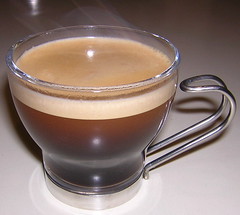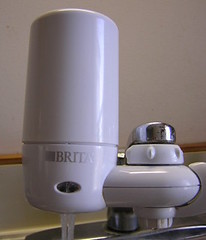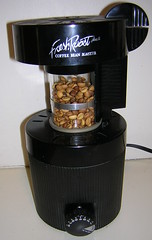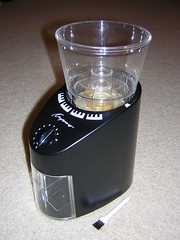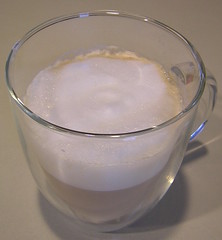
Fluid Dynamics and Perfect Espresso
A perfect espresso is more a function of science than art - contrary to many people's experience. The majority of the processes required to turn green coffee beans into a delicious espresso is dominated by fluid dynamics.
Water
An espresso is 98% water, so you don't want poor water quality to doom your espresso from the start. A relatively cheap and easy way to ensure good water is to pass it through an activated carbon filter. Fine granules of carbon are excellent at absorbing organic contaminants and, when combined with ionic-exchange, they can also remove calcium and magnesium to "soften" the water. The carbon is typically sourced from coconut shells. Many water filters also have traces of silver to discourage bacteria growth within the filter.
The pressure required to force water through a carbon filter is relatively high due to the high pressure drop (by design) across the carbon filter. The effectiveness of a carbon filter is proportional to the time the water spends in contact with the carbon, so the slower flow (due to the high pressure drop) is a necessary feature.
Roasting Coffee Beans
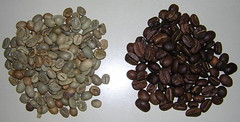 Coffee Beans: Green (unroasted) beans on the left and roasted beans on the right.
Coffee Beans: Green (unroasted) beans on the left and roasted beans on the right.
Roasting your own coffee beans is another easy way to better control the quality of your final espresso. While it sounds daunting, coffee bean roasting is a relatively quick and easy process. Using a simple convection roaster, such as the Fresh Roaster Plus 8, it takes less than 8 minutes to roast enough beans for about 5 espressos.
A convection roaster uses a hot plate at the base of a cylinder and blows air upwards over a measure of beans to continually heat them and keep them moving. The hot air vents through a torturous path that is capped with a metal gauze to capture chaff from the beans as they expand and shed their casing. The pressure drop caused by the roaster top and gauze is configured such that the air acting on the beans doesn't blow them too high away from the heat source.
Espresso Machine
A slow (high geared) conical burr grinder is essential to ensure a consistent fine-grind of the roasted coffee beans. The slower the grinder the better, which avoids heating the ground coffee.
Compacting (tamping) the right amount of ground coffee (grounds) and then forcing hot (not boiling) water through it completes the brewing process and, if everything is perfect, the espresso should be topped off with a thick layer of crema.
Some low-end espresso machines rely on the expansion of water close to boiling to provide the pressure to force water through a ground coffee shot. This approach causes the water to be too hot and doesn't deliver consistent high enough pressure.
A pump-based (semi-automatic) espresso machine that delivers upwards of 9bar is a minimum requirement to ensure enough force to push the water through the grounds. Again, as with the water filtering, the time the water is in contact with the grounds is critical, this time to ensure the optimal transfer of flavor to the water. An optimal setup is best judged by the production of a thick crema.
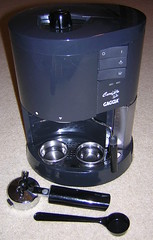 Semi-Automatic Espresso Machine
Semi-Automatic Espresso Machine
With a semi-automatic espresso machines there are a number of variables to master and optimize (especially coffee ground volume and tamping pressure); hence many cite the art, as opposed to science, of espresso making. However, there is an easier option for home espresso making, which it to use a combined grinder and espresso machine - a so-called super-automatic. A super-automatic espresso machine is typically cheaper than buying a separate conical burr grinder and semi-automatic espresso machine, so it's well worth the investment for a more consistent and automated process.
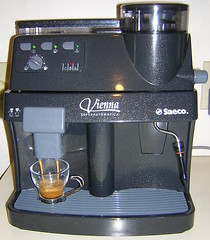 Super-Automatic Espresso Machine
Super-Automatic Espresso Machine
Latte and Cappuccino
If you find your espresso brewing isn't perfect one option to consider is adding steamed milk to make a latte. The milk will mask a suboptimal espresso and still makes for a tasty drink. Most espresso machines have a steam wand that supplies steam for producing lattes and cappuccinos. In the case of a latte the steam simply transfers heat to the milk.
For a cappuccino you want to entrain air into the milk to make a smooth layer of froth as well as heat the milk. There are various techniques to obtain optimal milk froth. Most espresso machines have a special nozzle to deliver steam and a small air inlet strategically placed above the milk level in a jug. The low pressure produced by the expanding steam sucks air through the air inlet which mixes with the turbulent steam jet and breaks up into small air bubbles trapped in the milk to give you your froth.
Latest Espresso Store
If this all sounds like too much effort or expense then consider visiting the latest innovation in coffee stores, where the entire store is configured to roast, grind and brew espresso in small batches to order.
Be warned though, once you've tasted freshly roasted, ground and brewed espresso there's no going back to merely filter coffee.
- Richard Smith's blog
- Login to post comments
Select Language
Recent blog posts
- CFD Simulates Distant Past
- Background on the Caedium v6.0 Release
- Long-Necked Dinosaurs Succumb To CFD
- CFD Provides Insight Into Mystery Fossils
- Wind Turbine Design According to Insects
- Runners Discover Drafting
- Wind Tunnel and CFD Reveal Best Cycling Tuck
- Active Aerodynamics on the Lamborghini Huracán Performante
- Fluidic Logic
- Stonehenge Vortex Revealed as April Fools' Day Distortion Field

